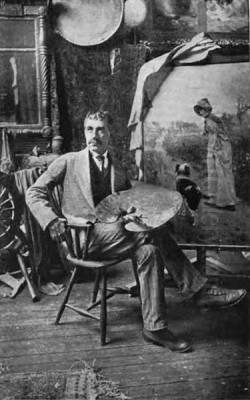
Hamilton Hamilton (1847-1928) stands as a notable figure in late 19th and early 20th-century American art, a painter whose career bridged the artistic traditions of Europe and the burgeoning visual identity of the United States. Born in Oxford, England, into a family of Scottish descent, his artistic journey was intrinsically linked with America, where he moved as a child and developed his distinct visual language. Though largely self-taught, Hamilton's dedication and innate talent propelled him to become a respected landscape and portrait painter, particularly celebrated for his evocative depictions of the American West and the gentler terrains of the East Coast.
Early Life and Artistic Beginnings
Born on April 1, 1847, in the historic city of Oxford, England, Hamilton Hamilton's early life was soon transplanted across the Atlantic. His family relocated to the United States when he was still young, settling in Cowlesville, New York, near Buffalo. This early exposure to the American environment would profoundly shape his artistic sensibilities. Unlike many of his contemporaries who sought formal academic training in the established art academies of Europe or America, Hamilton was predominantly an autodidact. His artistic education was a personal pursuit, driven by keen observation, relentless practice, and an independent study of the works of other masters he admired.
This path of self-instruction, while challenging, often fosters a unique and unencumbered artistic vision. For Hamilton, it meant developing a style that was both personal and responsive to the prevailing artistic currents of his time, most notably the burgeoning Impressionist movement. His early years were marked by a dedication to honing his skills in drawing and painting, laying the groundwork for a career that would span several decades and earn him considerable recognition.
The Lure of the American West
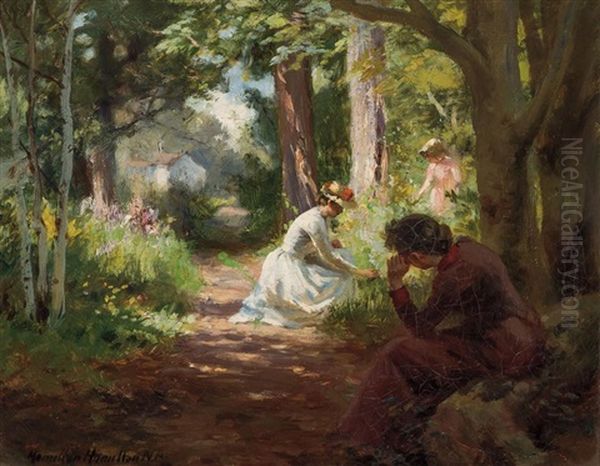
A pivotal moment in Hamilton Hamilton's early career was his expedition to the American West in 1873. At a time when the Western frontier was still a realm of wild beauty and immense fascination for artists and the public alike, Hamilton embarked on a sketching tour of Colorado. This journey was not merely a picturesque adventure; it was a profound artistic immersion. He returned from this expedition with a portfolio of approximately 47 paintings and sketches. These works were characterized by their bold execution and an impressionistic sensibility, capturing the raw grandeur, unique light, and expansive vistas of the Colorado landscapes.
These Western scenes were instrumental in establishing his reputation. Several of these pieces were exhibited at the prestigious Philadelphia Centennial Exposition of 1876, a major international fair that showcased American arts and industry to the world. His inclusion in such a significant event signaled his arrival as an artist of note. His depictions of the West, often imbued with a sense of atmosphere and a vibrant palette, contributed to the growing visual iconography of this defining American region, following in the spirit of earlier explorers and artists like Albert Bierstadt and Thomas Moran, though Hamilton brought his own, increasingly impressionistic, touch.
Artistic Style: Impressionism with an American Accent
Hamilton Hamilton's style is often described as Impressionistic, yet it retained a distinctly American character. While he absorbed the lessons of European Impressionism – its emphasis on capturing fleeting moments, the effects of light and atmosphere, and a brighter palette – his work often maintained a stronger sense of underlying structure and form than that of some of his French counterparts like Claude Monet or Camille Pissarro.
His brushwork was typically bold and energetic, conveying a sense of immediacy and vitality. He was particularly adept at rendering the interplay of light and shadow, whether on the rugged mountains of Colorado, the tranquil waters of a Long Island sound, or the pastoral fields of Connecticut. His landscapes were not mere topographical records but rather evocative interpretations of nature, imbued with mood and emotion. While known for landscapes, he was also a capable portrait painter, demonstrating versatility in his artistic practice. His genre scenes, often featuring figures in landscapes, particularly women and children, possess a gentle, idyllic quality, reflecting a common theme in American Impressionism.
Travels and European Exposure
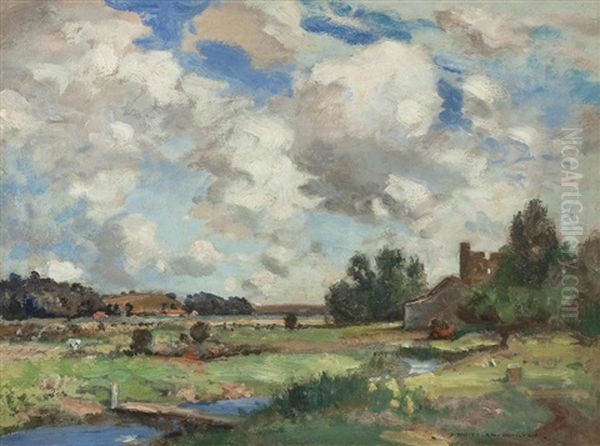
Like many American artists of his era, Hamilton Hamilton understood the importance of experiencing European art firsthand. He undertook several trips abroad, visiting England and France. These journeys provided him with opportunities to study the Old Masters and to engage with contemporary European art movements. In France, he would have encountered the full force of Impressionism and Post-Impressionism. His time in Pont-Aven, Brittany, a well-known artists' colony, was particularly significant. There, he worked alongside other painters, including the influential Paul Gauguin before Gauguin's more radical stylistic departures. This exposure to the artistic ferment of Europe undoubtedly enriched his palette and technique, further refining his impressionistic leanings.
These travels also allowed him to connect with other artists. While the specifics of all his collaborations are not exhaustively documented, the cross-pollination of ideas in such artistic hubs was invaluable. His ability to synthesize these European influences with his American subjects contributed to the distinctive quality of his work.
The Silvermine Guild and Connecticut Years
A significant portion of Hamilton Hamilton's adult life and career was centered in Connecticut. He became a prominent figure in the state's burgeoning art scene. Around 1906, he was instrumental in the formation of an artists' group in the Silvermine district, near Norwalk and New Canaan. This collective, initially an informal gathering of artists including sculptor Solon Borglum, eventually formalized into the Silvermine Guild of Artists in 1922. Hamilton was a founding member and played a key role in its early development.
The Silvermine Guild became an important center for artists in the region, fostering a supportive community and providing a venue for exhibitions. Its members included notable figures such as Daniel Putnam Brinley, Clifton Meek, and landscape painter Henry Hobart Nichols. Hamilton's involvement underscored his commitment to fostering artistic community and his leadership within it. His Connecticut landscapes from this period often depict the serene beauty of the New England countryside, a contrast to his earlier, more rugged Western scenes. These works reflect the influence of American Impressionists like John Henry Twachtman and J. Alden Weir, who were also deeply connected to the Connecticut landscape.
Recognition and Professional Affiliations
Hamilton Hamilton's talent did not go unrecognized by the formal art establishment. He was elected an Associate of the National Academy of Design (ANA) in New York in 1886, a significant honor. Just three years later, in 1889, he was elevated to the status of full Academician (NA), a testament to his standing among his peers. The National Academy of Design was, and remains, one of America's most prestigious art institutions, and membership was a clear mark of professional achievement. His colleagues at the Academy would have included many of the leading artists of the day, such as William Merritt Chase, Childe Hassam, and Winslow Homer.
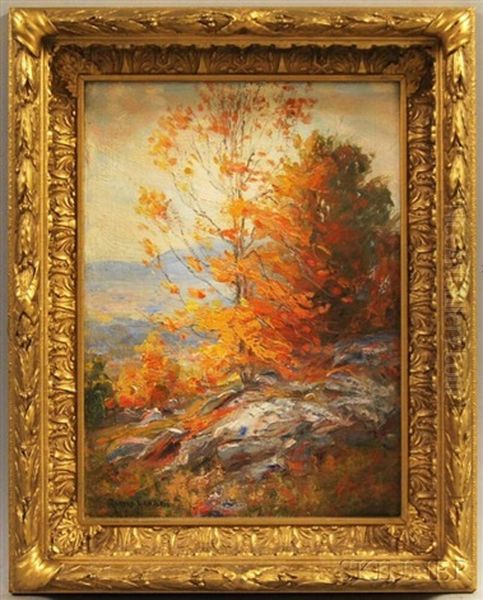
He was also a member of the American Watercolor Society, indicating his proficiency in that medium as well. His works were regularly exhibited at major venues, including the National Academy of Design, the Pennsylvania Academy of the Fine Arts, and the Art Institute of Chicago, among others. This consistent presence in important exhibitions helped to solidify his reputation and bring his work to a wider audience.
Notable Works and Thematic Concerns
While a comprehensive list of all his major works is extensive, certain themes and types of paintings are characteristic of Hamilton Hamilton's oeuvre. His Colorado landscapes from the 1870s, such as "The Last Gleam" or "View in the Rocky Mountains," are significant for their early adoption of an impressionistic approach to the grandeur of the West.
Later, his Long Island and Connecticut scenes often featured tranquil coastal views, pastoral landscapes, and genre scenes with figures, particularly women and children enjoying leisurely outdoor activities. Titles like "Gathering Flowers," "A Sunny Afternoon, Long Island Sound," or "Harvest Time, Long Island" evoke the gentle, sun-dappled quality of these works. These paintings align with the broader American Impressionist movement's interest in depicting scenes of leisure and the beauty of the cultivated or accessible landscape, differing from the sublime wilderness often favored by the earlier Hudson River School painters like Frederic Edwin Church or Asher B. Durand.
His portraits, though perhaps less numerous than his landscapes, were also well-regarded, demonstrating his skill in capturing likeness and character. Throughout his career, a consistent element was his sensitivity to light and atmosphere, rendered with a confident and often textured brushstroke.
Later Life and California Sojourn
In 1910, due to health concerns, Hamilton Hamilton briefly relocated to Pasadena, California. The California climate and landscape offered new subjects, and he continued to paint during his time there. This period, though short, adds another dimension to his artistic exploration of American scenery, placing him in the company of California Impressionists like Guy Rose and William Wendt, who were popularizing the "plein air" approach in the Golden State. He eventually returned to the East Coast, spending his final years in Norwalk, Connecticut, close to the Silvermine art colony he helped establish.
Critical Reception and Perceived Controversies
Hamilton Hamilton enjoyed considerable success and respect during his lifetime. His election to the National Academy of Design and his regular inclusion in major exhibitions attest to this. His work was appreciated for its technical skill, its pleasing subject matter, and its modern, impressionistic sensibility.
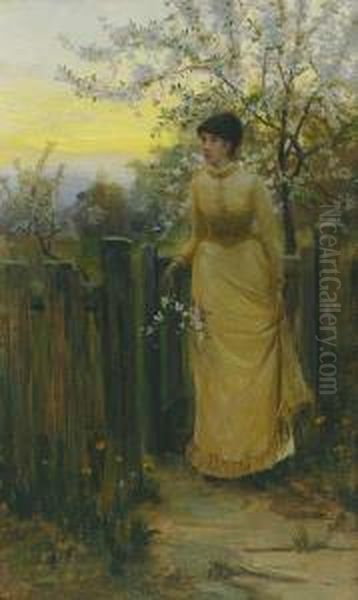
The provided information mentions a vague "controversy" regarding his "personal background complex (immigrant status, cross-cultural creation)" and that his art was "sometimes criticized for lacking depth or authenticity." It's important to approach such claims with nuance. For an artist born in England who became a quintessential painter of American scenes, questions of "authenticity" might have been raised by nativist critics, though this is speculative without specific sources. Such critiques were not uncommon for artists who didn't fit a narrow mold.
Furthermore, Impressionism itself, while popular, sometimes faced criticism from more conservative quarters for its perceived lack of "finish" or "seriousness" compared to academic realism. Any critique of "lacking depth" would need to be contextualized within the artistic debates of the period. It is more likely that Hamilton, like many successful artists, had his share of varied critical responses, but the overwhelming evidence points to a career marked by significant achievement and peer recognition. His self-taught background, rather than being a hindrance, might have allowed him a fresher perspective, but could also have been a point of contention for academically-minded critics. However, his acceptance into the National Academy strongly suggests his skills were highly regarded by the leading artists of his day.
Legacy and Collections
Hamilton Hamilton passed away on January 4, 1928, in Norwalk, Connecticut. He left behind a substantial body of work that captures the diverse beauty of the American landscape, from the rugged West to the serene East Coast. His paintings are held in the collections of numerous American museums, reflecting his enduring importance.
Institutions that house his work include the Cooper Hewitt, Smithsonian Design Museum (which evolved from the National Design Museum and has historic ties to the National Academy of Design), the Phoenix Art Museum, the Albright-Knox Art Gallery in Buffalo (near where he spent part of his youth), the Lowe Art Museum at the University of Miami, and the Columbus Museum in Georgia, among others. His paintings also appear in private collections and periodically surface at art auctions, where they continue to be appreciated by collectors of American Impressionism and Western art.
His role as a co-founder of the Silvermine Guild of Artists also stands as a lasting legacy, as the Guild continues to thrive as an important arts center to this day. He contributed not only through his own art but also by fostering an environment where other artists could flourish.
Conclusion
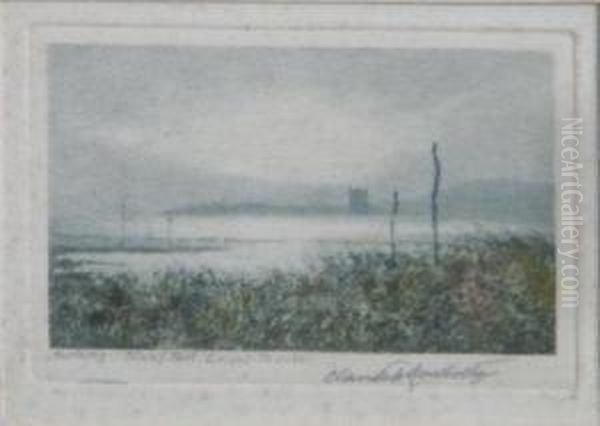
Hamilton Hamilton was a dedicated and talented artist who made a significant contribution to American art in the late 19th and early 20th centuries. As a largely self-taught painter, he forged a distinctive style that blended an appreciation for traditional landscape painting with the fresh perspectives of Impressionism. His depictions of the American West were pioneering in their atmospheric quality, while his Eastern landscapes and genre scenes captured the idyllic charm of a rapidly modernizing nation.
His transatlantic origins and experiences enriched his artistic vision, allowing him to interpret American subjects with a unique sensibility. Despite any minor critical reservations that may have existed, his successful career, his esteemed position within the National Academy of Design, his foundational role in the Silvermine Guild of Artists, and the continued presence of his works in public and private collections affirm his place as an important American painter. He remains a figure worthy of study for his beautiful renderings of light and landscape, and for his part in the vibrant story of American Impressionism. His contemporaries included a wide array of talents, from the epic Western visions of Thomas "Yellowstone" Moran to the refined Impressionism of Frank W. Benson and the urban observations of Robert Henri, all contributing to the rich tapestry of American art at the turn of the century. Hamilton Hamilton's brushstrokes are an integral part of that vibrant artistic heritage.